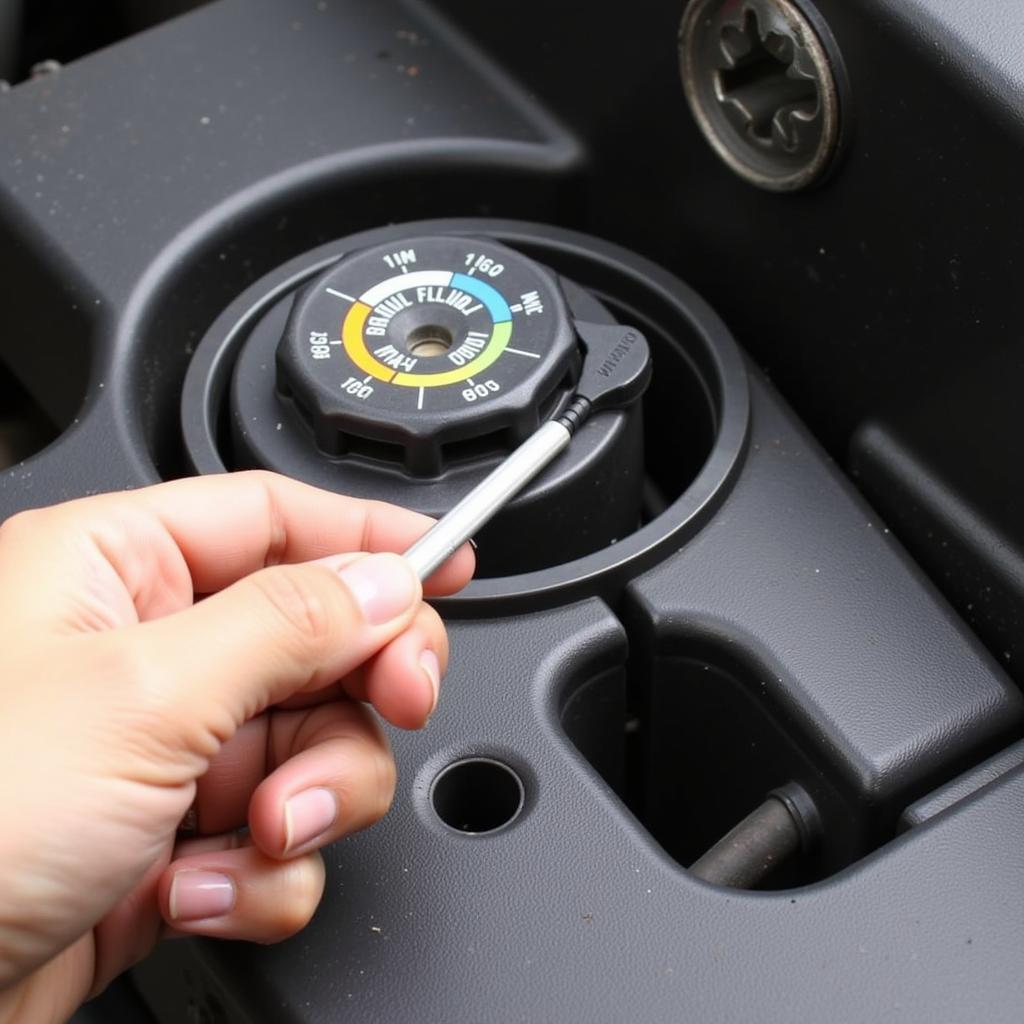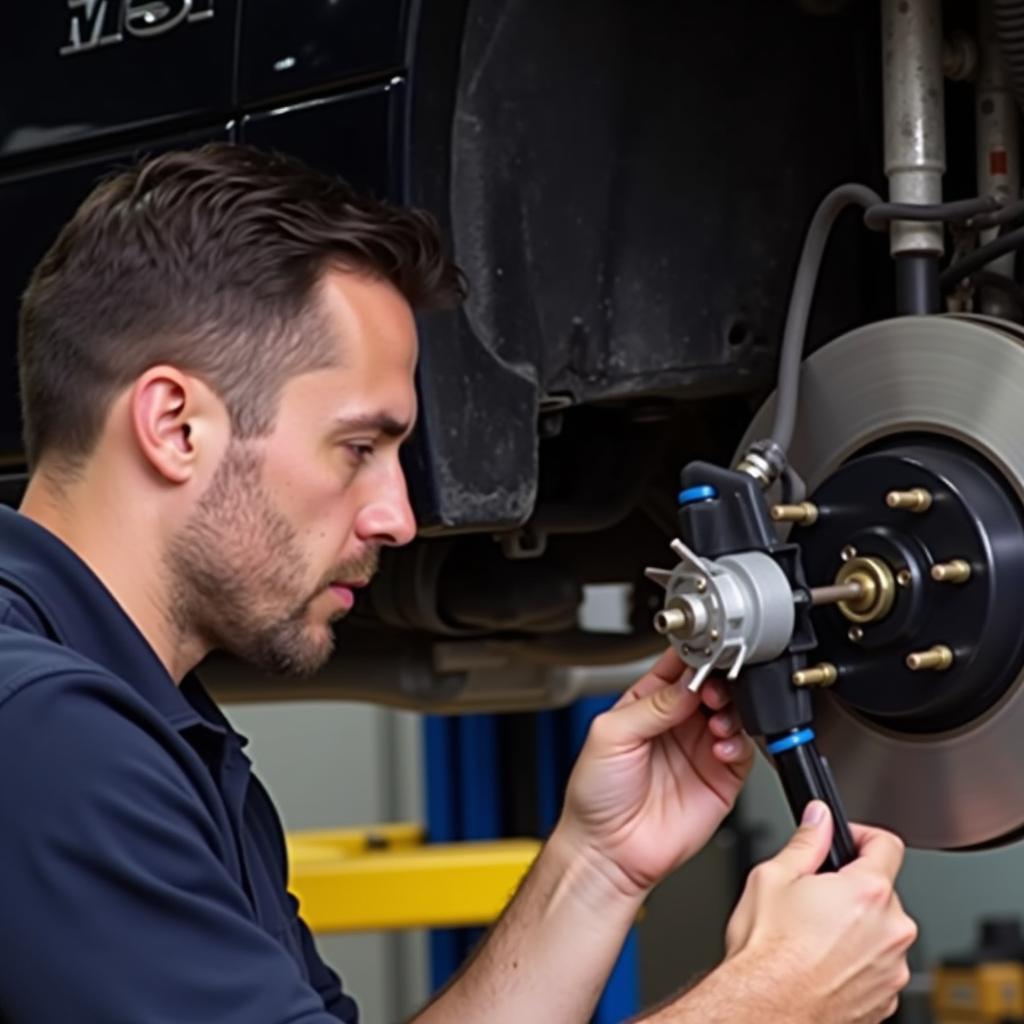The mini brake warning light on your dashboard can be a cause for concern. Understanding what it means and how long you can safely drive before addressing the issue is crucial for your safety and the longevity of your vehicle. Let’s dive into the details of this important warning signal.
Decoding the Mini Brake Warning Light
This light, often symbolized by an exclamation point within a circle and parentheses, usually indicates a problem with your braking system. It can signify a variety of issues, from low brake fluid to a more serious malfunction. Ignoring it can lead to costly repairs or even dangerous driving conditions. Want to upgrade your car’s audio system? Check out car radio cassette bluetooth.
Low Brake Fluid: The Most Common Culprit
The most frequent cause of the mini brake warning light is low brake fluid. Brake fluid is essential for transferring the force you apply to the brake pedal to the brake calipers, which then squeeze the brake pads against the rotors, stopping your car. A leak in the brake system can cause the fluid level to drop, triggering the warning light.
 Checking Car Brake Fluid Level
Checking Car Brake Fluid Level
Other Potential Causes of the Mini Brake Warning Light
While low brake fluid is the most common reason, other issues can trigger the warning light. These include a faulty brake sensor, worn-out brake pads, or problems with the ABS (Anti-lock Braking System). If you’re experiencing brake issues with your BMW X3, you might find this helpful: bmw x3 brake pads warning light.
Mini Brake Warning Light: How Long Can I Drive?
The simple answer is: as little as possible. A lit brake warning light indicates a potential safety hazard. While you might be able to drive a short distance to a safe location, continuing to drive with a compromised braking system is incredibly risky.
What to Do When the Light Comes On
- Pull over safely: Find a safe spot away from traffic to assess the situation.
- Check your brake fluid level: If you know how, carefully inspect the brake fluid reservoir. If it’s low, adding more fluid might temporarily solve the problem, but you still need to get the system inspected for leaks. Need to jumpstart your car? Learn how: charge dead battery with jumper cables.
- Call a mechanic: If you’re unsure about the cause or uncomfortable checking the fluid yourself, call a qualified mechanic immediately. Driving with a brake problem can be extremely dangerous.
“Ignoring a brake warning light is like playing Russian roulette with your safety,” says John Miller, a seasoned automotive technician with over 20 years of experience. “It’s never worth the risk.”
Ignoring the Warning: Potential Consequences
Ignoring the mini brake warning light can have severe consequences, including complete brake failure, leading to accidents and injuries. Additionally, continuing to drive with low brake fluid can damage the entire braking system, resulting in expensive repairs. Having trouble with your Lexus brake warning lights? Check out this resource: lexus abs brake warning lights.
“A small leak today can turn into a complete brake overhaul tomorrow. Address the issue immediately to save yourself time, money, and potential harm,” advises Sarah Chen, lead engineer at a major automotive parts manufacturer.
Mini Brake Warning Light: How Long Do I Have? Conclusion
The mini brake warning light signals a potential problem with your braking system. Don’t ignore it. Driving with a faulty braking system is dangerous. Address the issue immediately to ensure your safety and prevent further damage to your vehicle. Protecting your BMW key fob is important. Explore options here: bmw key fob cover.
FAQ
-
Can I drive with the mini brake warning light on? It’s highly recommended not to. Driving with a potential brake problem is extremely dangerous.
-
What should I do if the light comes on while I’m driving? Pull over safely as soon as possible and call a mechanic.
-
Is it always low brake fluid that causes the light to come on? While low brake fluid is the most common cause, other issues can trigger the light.
-
How much does it cost to fix a brake problem? The cost varies depending on the specific problem.
-
Can I add brake fluid myself? If you’re comfortable doing so, you can add brake fluid temporarily, but still get the system checked for leaks.
-
How often should I check my brake fluid level? Checking your brake fluid level every month is a good practice.
-
What does the mini brake warning light look like? It’s typically an exclamation point within a circle and parentheses.


